 English
English


resistance test of transformer
Resistance Test of Transformers An Essential Procedure for Ensuring Reliability
Transformers are critical components in electrical power systems, responsible for stepping up or stepping down voltage levels to facilitate efficient power transmission and distribution. To ensure their reliable operation, conducting a resistance test is essential. This test provides valuable insights into the condition of the transformer windings and helps identify potential issues that could lead to costly failures.
The resistance test of a transformer primarily measures the DC resistance of its windings. It is important to conduct this test at regular intervals, especially after installation, maintenance, or repair work. The primary reasons for performing a resistance test include verifying the integrity of the connections, assessing the uniformity of the winding resistance, and identifying any shorted or open turns within the windings.
Objectives of the Test
1. Identify Winding Integrity The test helps determine if there are any faults within the windings, such as partial shorts, which can significantly affect transformer performance.
2. Check Connections Resistance testing can reveal loose or corroded connections, which may cause overheating and failures if not addressed.
3. Assess Temperature Coefficients Resistance values change with temperature. Conducting the test at a controlled temperature allows for more accurate assessments and comparisons over time.
4. Baseline Data Establishing baseline resistance values during initial testing creates a reference point for future tests. By comparing these values over time, operators can monitor the transformer’s health and detect deterioration or unexpected changes.
resistance test of transformer

Testing Procedure
The resistance test is typically performed using a digital micro-ohmmeter or a low-resistance ohmmeter. The transformer should be de-energized and isolated from the power source before testing. The procedure involves the following steps
1. Preparation Ensure that the transformer is offline and all safety protocols are in place.
2. Connections Connect the testing leads to the transformer terminals, ensuring secure and correct connections to eliminate contact resistance influence.
3. Measurement Apply a known DC voltage and measure the resistance. It’s crucial to record values for all windings, including primary and secondary.
4. Analysis Compare the measured resistance values against the manufacturer’s specifications and historical data. A noticeable deviation could indicate potential issues that require further investigation.
Conclusion
The resistance test of transformers serves as a pivotal diagnostic tool in the maintenance and operation of power systems. Regular testing ensures the transformer operates efficiently and safely, prolonging its lifespan while minimizing the risk of unexpected outages. By implementing a comprehensive testing regime, electrical utilities and facility managers can assure themselves of the reliability and integrity of their transformers, ultimately leading to more stable and efficient power delivery.
-
Differences between open cup flash point tester and closed cup flash point testerNewsOct.31,2024
-
The Reliable Load Tap ChangerNewsOct.23,2024
-
The Essential Guide to Hipot TestersNewsOct.23,2024
-
The Digital Insulation TesterNewsOct.23,2024
-
The Best Earth Loop Impedance Tester for SaleNewsOct.23,2024
-
Tan Delta Tester--The Essential Tool for Electrical Insulation TestingNewsOct.23,2024





